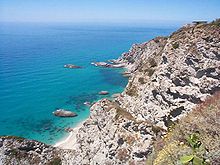| This article needs additional citations for verification. Please help improve this article by adding citations to reliable sources. Unsourced material may be challenged and removed. Find sources: "Capo Vaticano" – news · newspapers · books · scholar · JSTOR (September 2024) (Learn how and when to remove this message) |
 | |
| Location | Capo Vaticano, Ricadi, Italy |
|---|---|
| Coordinates | 38°37′10″N 15°49′43″E / 38.61939°N 15.828687°E / 38.61939; 15.828687 |
| Tower | |
| Constructed | 1885 |
| Height | 8 m (26 ft) |
| Power source | mains electricity |
| Light | |
| Focal height | 108 m (354 ft) |
| Lens | second order Fresnel lens |
| Range | 24 nmi (44 km; 28 mi) |
| Characteristic | Fl(4) W 20s |
Capo Vaticano is a wide bathing place in the Municipality of Ricadi in Calabria, Italy. The 'Cape' is formed by a particular white-grey granite, which is examined worldwide for its geologic characteristics.
Geography

The maximum altitude of the cape is about 124 metres.
The coast of Capo Vaticano starts from Santa Maria beach up to Tonicello beach. The most suggestive bays near the Cape are Praia I Focu and Grotticelle.
History
The famous Venetian writer Giuseppe Berto made Capo Vaticano his home, after travelling throughout Italy. "Capo Vaticano", he wrote, "is called Vatican as a Roman hill: once priests and fortune tellers searched for the future basing their predictions on birds' flights. 200 metres over the Cape there is a rock called Mantineo and in ancient Greek, it means: to communicate with God. The Cape was a holy place and now it is the same."
Economy
Capo Vaticano is considered the ideal place to have a climate suitable for growing the Red onions of Tropea.
See also
References
External links
Portal:This Calabrian location article is a stub. You can help Misplaced Pages by expanding it. |